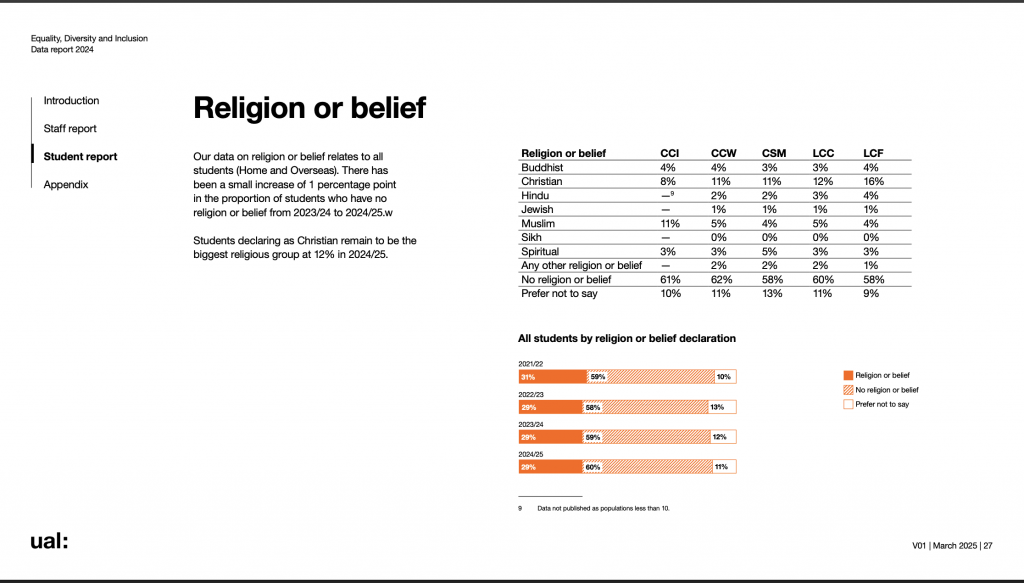Discuss examples from the resources that illustrate the intersection of faith with other identity aspects.
Kwame Appiah offered a unique approach in which he stated that ‘There isn’t a thing such as religion, such as thing as religion, and that therefore what they say cannot possibly be true’ (Appiah, 2014) This statement has reverberated around my brain for some time and whilst I am still not sure I fully understand its intent, I understand the ability to be culturally Jewish (or any other religion) and not believe in God. Here the intersection of race and religion are being dissected.
Professor Simian Jeet Singh from Trinity University shared the intersectionality of faith and race and how he actively counters racial prejudice when he gets on a plane by being jocular and sharing pictures of his family (Trinity University, 2016). I found this piece difficult to digest and was disheartened to hear that he felt that he by engaging in performative congeniality he was able to counter any disquiet fellow passengers had. This is especially galling as he is obviously Sikh, and therefore does not share a religious identity with those he perpetrated the terrorist attacks on 9/11 or the World Trade Centre which presumably his fellow passengers are concerned with. Here the intersectionality of race, sex and religion are the causes of discrimination.
Jawad highlighted that Muslim women are made visible through their use of the hijab and this exposes them to more religiously motivated discrimination. They are visibly Muslim in a way that Muslim men are not. They are also othered by their choice not to wear clothing with a high level of exposure or participate in a mixed sex arena. X made strong arguments and linked to the religious source, the Quran to highlight that women’s participation in sport is encouraged and highlighted, but that this does not translate into the lived experience of Muslim women’s lives were they are discriminated but traditional societies and then against by Western secular governments and some international sports bodies (Jawad, 2022).
Considering the context of the resources you use, note any recurring themes or differing perspectives.
I found these three accounts varying wildly, from refuting the notion of religion, to proving a religion meant no harm, to asserting that your religious practice should be recognised in non-traditional spaces. It was an interesting flow of experiences from denial, accommodation to insistence. All speakers came from the global majority and Appiah spoke of the identification of the idea of religion being chiefly of concern to Christians, as they were keen to assert themselves over populations that were not Christian wherever they went, specifically looking to the Middle Ages and the time of Columbus. If there was a thread, it was that in each case religion was being demystified or its differences downplayed or its differences negated to enable participation.
List the faith considerations in your own teaching context, drawing on UAL data and your own experience.
Whilst religion is a protected characteristic it is one that does not play a major role within my teaching context. Whilst I make pains to identify myself in various ways as an EDI ally, I cannot say that I consciously and deliberately place religion within that or the programme, despite my Christian faith playing a huge role in my private life. One reason for this is that Christianity which has become a source of controversy with its outdated views on key issues such equality and same sex marriage (Oborne, 2022). These perceptions are at odds with my identity as a progressive ally and someone reasearching and working in the EDI space. Another is to recognise that whilst UAL data suggests that 29% of students identified as having a faith or belief with 12% declaring that they are Christians, 60% stated they have no faith or religious belief system (UAL, 2024). This must also be recognised and respected. The ultimate goal is as stated on UAL’s EDI page that we remain ‘inclusive and safe environment where everyone can thrive and fulfil their potential’ (UAL, no date).

(Image: UAL, 2024)
Conclusions
The texts examined the ways that religion intersect with race and sex and how this creates unique pockets of discrimination within protected characteristics. This was highlighted by Crenshaw when she first coined the term intersectionality as a result of two cases where black women were unable to claim race and sex discrimination as they could not proved sex discrimination, as other white females were not discriminated against, nor could they prove race discrimination, as black males were not discriminated against (Crenshaw, 1989). This and the examples above echo the words of The Centre for Ageing Better (2020) which referred to the intersectionality of age and sex as ‘double jeopardy’. It is clear that these relationships affect individuals differently and must be recognised as being areas of further discrimination.
Appiah, K. A (2014) Is religion good or bad? (This is a trick question). YouTube video, added by TED [Online]. Available at: https://www.youtube.com/watch?v=X2et2KO8gcY (Accessed: 17 May 2025).
Jawad, H. (2022) Islam, women and sport: the case of visible Muslim women. Religion and Global Society, London School of Economics. Available at: https://blogs.lse.ac.uk/religionglobalsociety/2022/09/islam-women-and-sport-the-case-of-visible-muslim-women/ (Accessed: 17 May 2025).
Oborne, M. (2022) Where is discrimination against women still allowed in the UK? The church. Available at: https://www.theguardian.com/commentisfree/2022/nov/11/discrimination-against-women-church-of-england-women-priests (Accessed: 19th May 2025)
Rekis, J. (2023) Religious Identity and Epistemic Injustice: An Intersectional Account. Hypatia, 38, pp. 779–800. doi:10.1017/hyp.2023.86 (Accessed: 7 May 2025).
Trinity University (2016) Challenging Race, Religion, and Stereotypes in the Classroom. YouTube video, added by TED [Online]. Available at: https://www.youtube.com/watch?v=0CAOKTo_DOk (Accessed: 19th May 2025).
UAL (2024) Equality, Diversity and Inclusion Data report 2024. Available at: https://www.arts.ac.uk/__data/assets/pdf_file/0030/472836/UAL-EDI-data-report-2024-PDFA.pdf (Accessed 22nd May 2025)
UAL (no date) Equality, Diversity and Inclusion. Available at: https://www.arts.ac.uk/about-ual/equality-and-diversity (Accessed 22nd May)
Leave a Reply